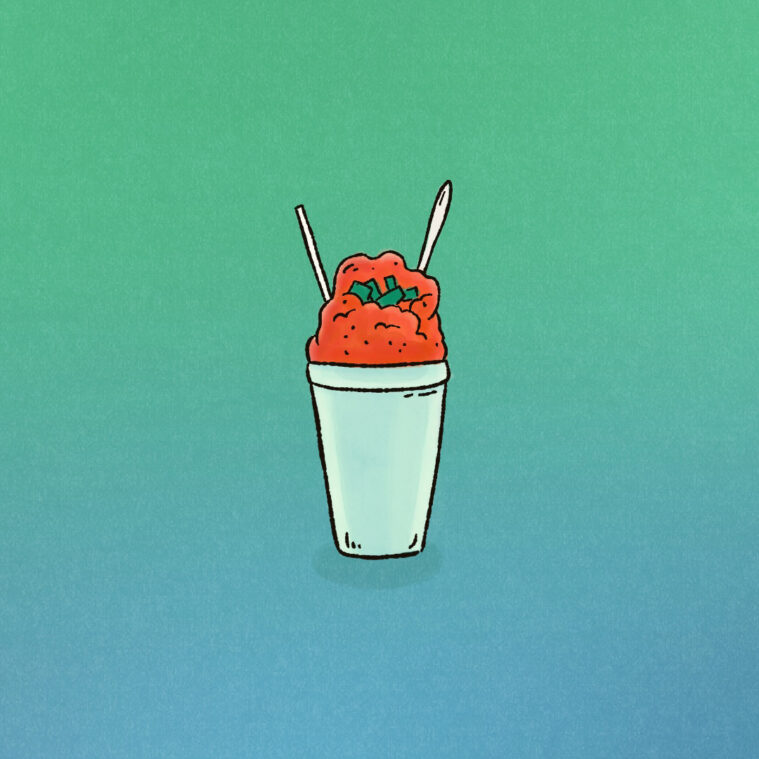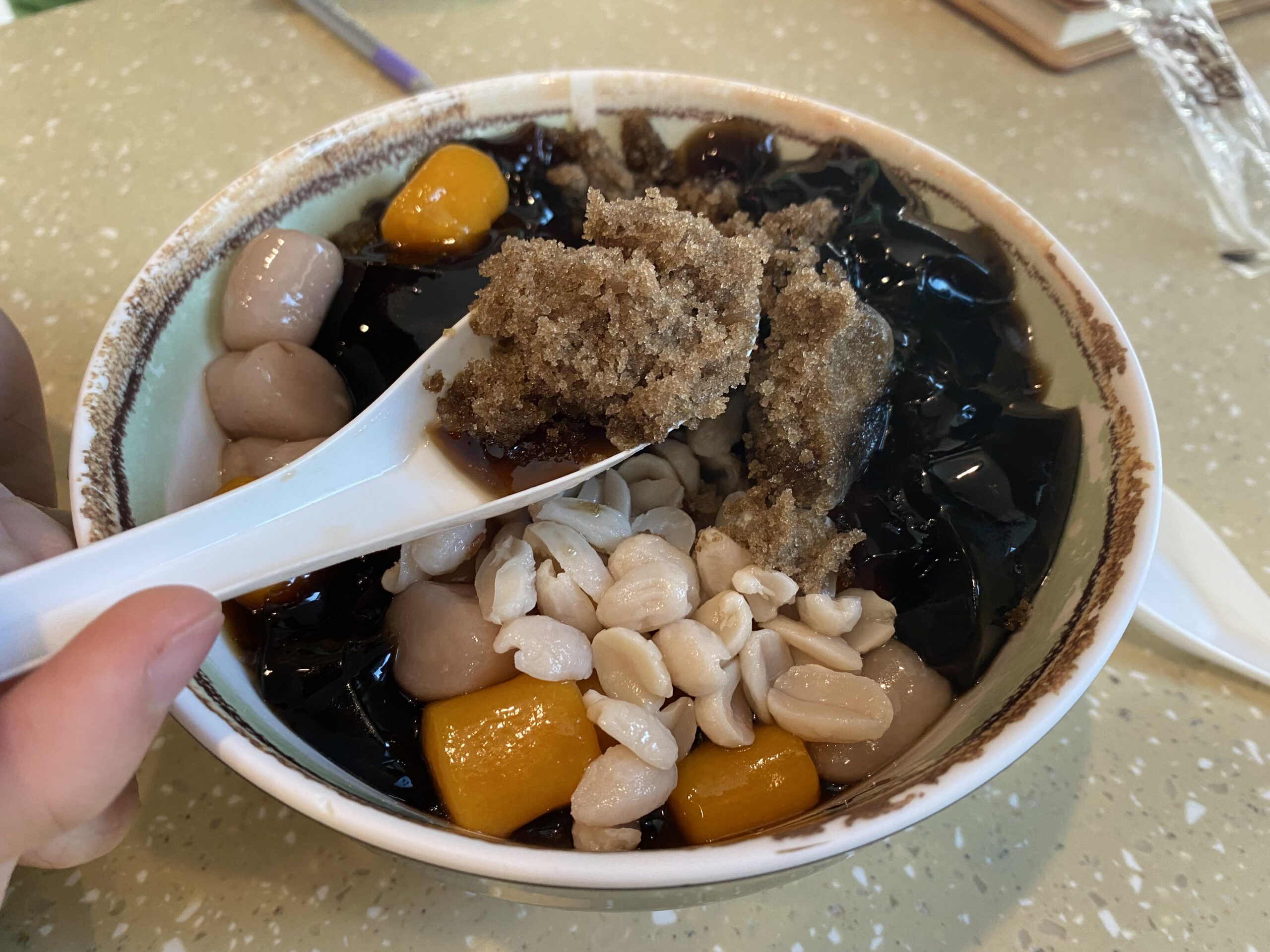During World War II, when American planes bombed Taiwan’s sugar mills, my grandfather stashed the sweet gold he’d saved under the floorboards. After the war ended, he took sugar and hefty blocks of ice and set up a tusa bing, or shaved ice stall, in the neighborhood’s open market. Using a machete, he flayed the ice until fine flakes lined the bottom of the bowl. Pouring over syrup made from his treasure trove and topping the frozen treat with sweet red beans, he served it to the locals on Bi Shi Tao Road in Kaoshiung looking to beat the heat.
Even though I grew up on Taiwanese shaved ice and have studied its evolutions since it was served in back alley stalls, I’m no shaved ice snoot. During the extreme heat this year, I’d have been happy to take any form of ice—plant my face in it, pour it down my back, or just sit on a block of it.
During the extreme heat, I’d have been happy to take any form of ice—plant my face in it, pour it down my back, or just sit on a block of it.
Different cultures have developed their own versions of shaved ice—the Indian baraf ka gola, the Iranian faloodeh, and the Korean bingsu—and brought them here to Houston. While I couldn’t include everything here, my egalitarian spirit took me across the Bayou City to sample what its diverse communities have to offer.
Colonial history in a cup

For three continuous days in July of 1946, the people of the Philippines celebrated the country’s newly won independence from the United States—and the formation of its third republic—with shaved ice. The halo-halo, which is Tagalog for “mix-mix,” is a culinary representation of years of colonial rule and independence. The Japanese brought the kakigori, or shaved ice sweetened with condensed milk and red beans, and the Americans built the first ice plant to supply the ice. But the real star, I believe, is the native ube or purple yam ice cream, which sits on top of the halo-halo. One can find many variations of this dessert in the city of Houston. I went to the popular Filipino chain Gerry’s Grill, which opened a location in southwest Houston in 2018.
Managers Liz de la Rosa and Dennis Mayoral shared their version of the halo-halo, which starts with a sticky ube custard on the bottom, then gets dots of sweet al dente red beans, mung beans, and fresh shredded coconut, over a layer of sweet milky ice. It is all then topped with creamy flan and rich, earthy ube ice cream and sprinkled with Filipino rice krispies.
“Because we are not blessed with an A/C in our homes, we go to the beach. More recently, I went to Boracay Beach. That was the first time that I sampled this particular milky ice version of the halo-halo.” Mayoral said he brought the idea to Gerry’s Grill. Instead of mixing the ice with milk and sugar, they first blend condensed milk, powdered milk, evaporated milk, and sugar, then freeze the mixture and shave it. That way, as it melts, the sweet milk isn’t watered down.
I was tempted to eat the halo-halo from top to bottom, tasting each ingredient separately. But when I suggested it, de la Rosa and Mayoral gave me disapproving head-shakes, the likes of which you might get from New Yorkers if you don’t fold your pizza or from Texans if you eat barbecued ribs with a fork. Under their patient tutelage, I learned to blend all the ingredients in the halo-halo, getting an eye-opening interplay of tastes and textures in each spoonful.
Gerry’s Grill, 6833 W Sam Houston Pkwy S, Houston, TX 77072, (832) 582-8638
Displaced ice finds a new home

It’s estimated that 250,000 people fled to Houston and 100,000 stayed and made the city their home after Hurricane Katrina decimated New Orleans in 2005.
Native New Orleanian Denise Tankersley, who spent her childhood summers working in a New Orleans’ Snoball Hut, decided to serve displaced New Orleanians a taste of home. In 2009, she and her husband John Tankersely opened Sno Dreamz, which started as an ice shack in southwest Houston not unlike the one Denise worked in as a kid. Daughter Courtney Tankersly continued the tradition, opening up her own store across from the University of Houston football stadium in the Third Ward.
“It’s just a family thing. People look for a connection back home when they move, and we want to make them happy, help them cool off, and give them a treat that’s part of their culture,” Courtney said.
Courtney even uses a Sno-Wizard: a machine first invented in 1936 by a New Orleans neighborhood grocer named George Ortolano, who figured out how to make fluffy shaved ice around the same time the colonizing Japanese did.

When I went to visit her store, people were already lined inside staring at the dizzying array of flavors on the menu. There are over 80 flavors of snoballs, ranging from fruity to creamy to the all-natural. Specialty snoballs include a king cake flavor, a Mardi Gras tradition. Besides that, the Tankersleys serve New Orleans goodies like boudin, pig lips, and kool lickles—a pickle marinated in Kool-Aid. Courtney has the Pick-a-Dilly snoball on her menu, a variation of the kool lickle in shaved ice form. The Pick-a-Dilly tastes true to the kool lickle’s ingredients—a sweet and tangy icy mix of Kool-Aid and dilly pickle juice topped with pickle bits that add a firmer crunch to the soft ice.
Not having grown up with the nostalgic taste of the kool lickle, I preferred Courtney’s favorite, a specialty snoball called the dragon’s blood mixed with punchy fruit and crisp Granny Smith apple flavors. It has that balanced slushy blend of sweet and sour without making your lips pucker and your eyes squint—reflexes that might have been embarrassingly mistaken for awkwards acts of seduction when all I wanted to do was just enjoy my snoball.
Sno Dreamz 3402 Scott St #100a, Houston, TX 77004, (713) 373-1555 and 11320 Fondren Rd Houston, TX 77035 (713) 728-1550
Medicinal ice

Every time I had a sore throat as a child, my parents would tell me I had too much shang huo. Ulcers in my mouth? Too much shang huo. Rashes on my back? Too much shang huo. The big zit in the center of my face on prom night? Too much shang huo.
Shang huo can best be described as body heat that leads to inflammation. East Asians believe that to qu huo, or “put out the fire,” we have to eat certain foods. This has nothing to do with temperature. It means eating less spicy and fried foods and eating more foods like bananas, bitter melons, pears, and cincau, or grass jelly.
For hundreds of years, the Chinese have been boiling the leaves and stems of the mesona plant, then drinking the tea or mixing the tea with small amounts of cornstarch and rice flour to make the cincau, which is known to reduce blood pressure, cholesterol, and inflammation. Seen as a gift from the gods, legend has it that it was called “immortal grass” or “celestial grass”—not to be confused with the other celestial grass more commonly smoked by Americans.
Meet Fresh, a Taiwanese chain with three locations in Texas, including Houston, Katy, and Plano. It is the only place I know of that makes shaved ice with cincau.

The first U.S. location opened in California, where owner Vince Guo was living at the time. Guo traveled nearly an hour three days a week just to get its best-selling icy grass jelly signature. He says his Houston store sells more than a hundred orders of the icy grass jelly signature every day. While there’s about a dozen Taiwanese shaved ice places in Houston, Guo adds that Meet Fresh is special because it gets its ingredients directly from Taiwan. This includes the herbal tea to make the signature ice and the grass jelly.
To make the ice, Meet Fresh uses an ice cream maker to turn the herbal tea into shaved ice. The silky melt-on-your-tongue grass jelly is then folded over the herbal ice and contrasted with toppings of chewy taro balls made from the root vegetable flour. The dish uses subtle amounts of sugar—so subtle that I can tell myself I’m burning more sugar than I am taking in.
Guo also had me try the pudding and mochi shaved ice. It’s a mountain of shaved ice soaked through with condensed milk and brown sugar syrup. At the touch of my spoon, the snowy mountain started to cascade in a powdery avalanche, gathering below in a milky lake, perfect to try with the Taiwanese dessert favorites that envelop the base—fluffy almond pudding, silky caramel egg pudding, chewy rice mochi rolls, and the modest winter melon jelly.
Meet Fresh, 9393 Bellaire Blvd., Unit I, Houston, TX 77036 (832) 582-5994
‘It’s just a Houston thing’

I wouldn’t be able to write about shaved ice in Houston without mentioning Mexican raspados or raspas, which literally means “shaved.”
At Tampico Refresqueria, I met couple Vincent and Pilar Ngo, who frequent the popular Heights neighborhood raspas stand three times a week. Pilar grew up in Michoacan, Mexico, where raspas were sold from pushcarts and bicycles at every corner. But Pilar prefers the raspas her mom made for her and four other siblings using a simple metal raspador. The hand-held tool shaves the ice into a small compartment, which can then be poured into a cup and topped with fresh fruit juices and other flavors.
Of course, with the constant rush of people passing their stands, Tampico uses a commercial shaved ice machine. While they have an extensive menu, the bestsellers are their naturally-flavored raspas: leche (milk), fresa (strawberry), tamarind, and chamoyada.
Chamoyada can only be described as a paradox of flavors. It takes juice made from frozen mango, Chamoy salsa, Tajín chili powder, and shaved ice. Weirdly enough, the chamoyada warms your throat and chills you at the same time. The spicy ice finds its counterpart in the raspas de leche. Made with a blend of milk, cinnamon, and sugar, it tastes like an horchata slurpee—except calling it a slurpee would blaspheme this holy trinity of flavors.
Vincent, who grew up in a Vietnamese family, says he prefers the Mexican raspas over the Vietnamese version of shaved ice called the chè ba màu, or any ice cream. He’s been coming to Tampico since he was a teen.
“It’s local. It’s something you grow up with. Get with your friends. It’s just a Houston thing, you know.”
Tampico Refresqueria: 4520 N Main St, Houston, TX 77009, (713) 880-3040 and 3700 Irvington Blvd, Houston, TX 77009, (713) 225-3040.







